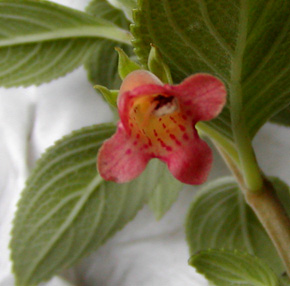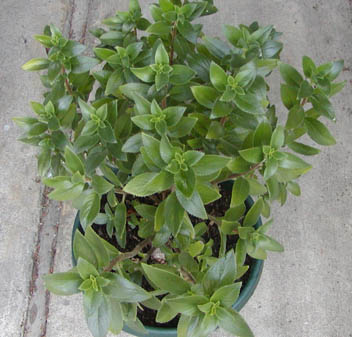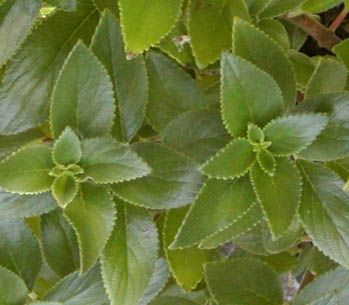Vanhouttea calcarata
Compared to that of Vanhouttea lanata, this flower of Vanhouttea calcarata has rounder lobes and the stripes do not extend from the throat into the lobes.

| Species list |
Hybrids list |
Tubers list |
Topics list |
Site index |
What's new |
Home page |
Vanhouttea calcarataCompared to that of Vanhouttea lanata, this flower of Vanhouttea calcarata has rounder lobes and the stripes do not extend from the throat into the lobes. |

|

|
This picture shows the whole plant, in a 12-inch [30-cm] pot. It was an attractive shrubby plant, but rarely flowered under my conditions. |
FoliageThis picture shows a closer view of the foliage and the serration of the leaves. Because most vanhoutteas do not bloom easily outside Brazil, we have a page showing a comparison of the leaves of four vanhouttea species. UpdateAll my plants of Vanhouttea calcarata, including a well-established plant in the ground, died in the freeze of January 2007, although several plants of V. lanata and V. brueggeri survived. This is one of those times it is easy to look on the bright side. Given the meager flower production in the eight years I had this species, I did not mourn its loss. |

|
| Plant Description |
|
| Growth | Indeterminate |
| Habit | Shrub |
| Leaves | Green, finely scalloped |
| Dormancy | No tuber |
Flowering |
|
| Season | Summer |
| Flower | Red, funnelform |
Horticultural aspects |
|
| Hardiness | It survived 29 F (-1.5 C) in my yard, but defoliated completely in any frost and showed leaf damage from night temperatures in the 30s. It was the most cold-vulnerable of the vanhoutteas in my yard |
| Recommended? | No. |
Botany |
|
| Taxonomic group | In a vanhouttea subgroup of the Sinningia clade. |
External linkThe Brazil Plants website has a page on this species. |
PublicationAntoine Charles Lemaire (1801-1871), in 1845. Lemaire also named the cactus genus Cleistocactus (of which I have several). Vanhouttea calcarata is the type species of Vanhouttea. Etymology: probably has something to do with Latin calcar ("spur"). Latin calcareus ("heel") is not a good bet, because any derivatives would have retained the -re- ("calcareatus"). So we assume "spurred", but where is the spur? [According to John Boggan, this "species was described from an aberrant flower that had a `horn' or spur on the top of the flower".] |